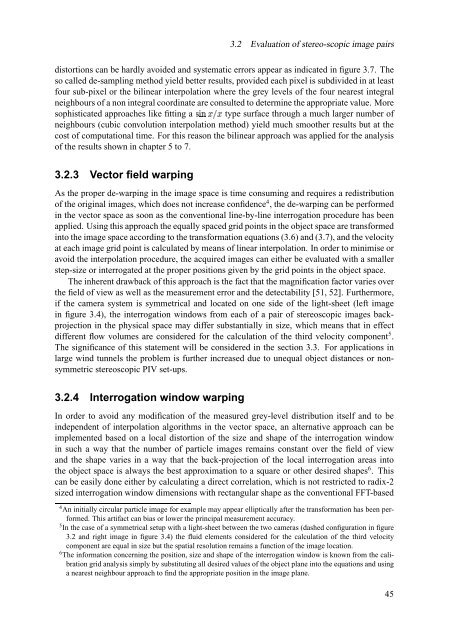The significance of coherent flow structures for the turbulent mixing ...
The significance of coherent flow structures for the turbulent mixing ...
The significance of coherent flow structures for the turbulent mixing ...
Create successful ePaper yourself
Turn your PDF publications into a flip-book with our unique Google optimized e-Paper software.
3.2 Evaluation <strong>of</strong> stereo-scopic image pairs<br />
distortions can be hardly avoided and systematic errors appear as indicated in figure 3.7. <strong>The</strong><br />
so called de-sampling method yield better results, provided each pixel is subdivided in at least<br />
four sub-pixel or <strong>the</strong> bilinear interpolation where <strong>the</strong> grey levels <strong>of</strong> <strong>the</strong> four nearest integral<br />
neighbours <strong>of</strong> a non integral coordinate are consulted to determine <strong>the</strong> appropriate value. More<br />
sophisticated approaches like fitting a ¬v®pâäã¡åÀã type surface through a much larger number <strong>of</strong><br />
neighbours (cubic convolution interpolation method) yield much smoo<strong>the</strong>r results but at <strong>the</strong><br />
cost <strong>of</strong> computational time. For this reason <strong>the</strong> bilinear approach was applied <strong>for</strong> <strong>the</strong> analysis<br />
<strong>of</strong> <strong>the</strong> results shown in chapter 5 to 7.<br />
3.2.3 Vector field warping<br />
As <strong>the</strong> proper de-warping in <strong>the</strong> image space is time consuming and requires a redistribution<br />
<strong>of</strong> <strong>the</strong> original images, which does not increase confidence 4 , <strong>the</strong> de-warping can be per<strong>for</strong>med<br />
in <strong>the</strong> vector space as soon as <strong>the</strong> conventional line-by-line interrogation procedure has been<br />
applied. Using this approach <strong>the</strong> equally spaced grid points in <strong>the</strong> object space are trans<strong>for</strong>med<br />
into <strong>the</strong> image space according to <strong>the</strong> trans<strong>for</strong>mation equations (3.6) and (3.7), and <strong>the</strong> velocity<br />
at each image grid point is calculated by means <strong>of</strong> linear interpolation. In order to minimise or<br />
avoid <strong>the</strong> interpolation procedure, <strong>the</strong> acquired images can ei<strong>the</strong>r be evaluated with a smaller<br />
step-size or interrogated at <strong>the</strong> proper positions given by <strong>the</strong> grid points in <strong>the</strong> object space.<br />
<strong>The</strong> inherent drawback <strong>of</strong> this approach is <strong>the</strong> fact that <strong>the</strong> magnification factor varies over<br />
<strong>the</strong> field <strong>of</strong> view as well as <strong>the</strong> measurement error and <strong>the</strong> detectability [51, 52]. Fur<strong>the</strong>rmore,<br />
if <strong>the</strong> camera system is symmetrical and located on one side <strong>of</strong> <strong>the</strong> light-sheet (left image<br />
in figure 3.4), <strong>the</strong> interrogation windows from each <strong>of</strong> a pair <strong>of</strong> stereoscopic images backprojection<br />
in <strong>the</strong> physical space may differ substantially in size, which means that in effect<br />
different <strong>flow</strong> volumes are considered <strong>for</strong> <strong>the</strong> calculation <strong>of</strong> <strong>the</strong> third velocity component 5 .<br />
<strong>The</strong> <strong>significance</strong> <strong>of</strong> this statement will be considered in <strong>the</strong> section 3.3. For applications in<br />
large wind tunnels <strong>the</strong> problem is fur<strong>the</strong>r increased due to unequal object distances or nonsymmetric<br />
stereoscopic PIV set-ups.<br />
3.2.4 Interrogation window warping<br />
In order to avoid any modification <strong>of</strong> <strong>the</strong> measured grey-level distribution itself and to be<br />
independent <strong>of</strong> interpolation algorithms in <strong>the</strong> vector space, an alternative approach can be<br />
implemented based on a local distortion <strong>of</strong> <strong>the</strong> size and shape <strong>of</strong> <strong>the</strong> interrogation window<br />
in such a way that <strong>the</strong> number <strong>of</strong> particle images remains constant over <strong>the</strong> field <strong>of</strong> view<br />
and <strong>the</strong> shape varies in a way that <strong>the</strong> back-projection <strong>of</strong> <strong>the</strong> local interrogation areas into<br />
<strong>the</strong> object space is always <strong>the</strong> best approximation to a square or o<strong>the</strong>r desired shapes 6 . This<br />
can be easily done ei<strong>the</strong>r by calculating a direct correlation, which is not restricted to radix-2<br />
sized interrogation window dimensions with rectangular shape as <strong>the</strong> conventional FFT-based<br />
4 An initially circular particle image <strong>for</strong> example may appear elliptically after <strong>the</strong> trans<strong>for</strong>mation has been per<strong>for</strong>med.<br />
This artifact can bias or lower <strong>the</strong> principal measurement accuracy.<br />
5 In <strong>the</strong> case <strong>of</strong> a symmetrical setup with a light-sheet between <strong>the</strong> two cameras (dashed configuration in figure<br />
3.2 and right image in figure 3.4) <strong>the</strong> fluid elements considered <strong>for</strong> <strong>the</strong> calculation <strong>of</strong> <strong>the</strong> third velocity<br />
component are equal in size but <strong>the</strong> spatial resolution remains a function <strong>of</strong> <strong>the</strong> image location.<br />
6 <strong>The</strong> in<strong>for</strong>mation concerning <strong>the</strong> position, size and shape <strong>of</strong> <strong>the</strong> interrogation window is known from <strong>the</strong> calibration<br />
grid analysis simply by substituting all desired values <strong>of</strong> <strong>the</strong> object plane into <strong>the</strong> equations and using<br />
a nearest neighbour approach to find <strong>the</strong> appropriate position in <strong>the</strong> image plane.<br />
45
















